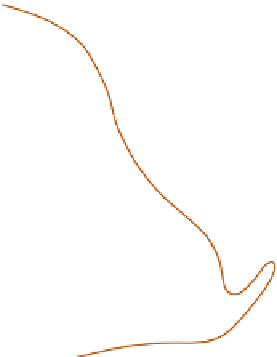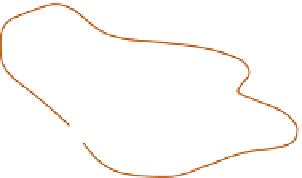Geoscience Reference
In-Depth Information
60°N
30°
0
0°
Tahiti
Darwin
30°S
Figure 11.49
The correlation of mean annual sea-level pressures with that at Darwin, Australia, illustrating the two
major cells of the Southern Oscillation.
Source: Rasmusson (1985). Copyright © American Scientist, (1985).
11.49
). It has an irregular period of between two
to ten years. Its mechanism is held by some experts
to center on the control over the strength of the
Pacific Trade Winds exercised by the activity of the
subtropical high pressure cells, particularly the
one over the South Pacific. Others, recognizing the
ocean as an enormous heat energy source, believe
that near-surface temperature variations in the
tropical Pacific may act somewhat similar to a
flywheel to drive the whole ENSO system (see
Box 11.1
)
. It is important to note that a deep (i.e.,
100m+) pool of the world's warmest surface
water builds up in the western equatorial Pacific
between the surface and the thermocline. This is
set up by the intense insolation, low heat loss from
evaporation in this region of light winds, and the
piling up of surface water driven westward by the
easterly Trade Winds. The warm pool is dissipated
periodically during El Niño by the changing ocean
currents and by heat release into the atmosphere
- directly and through evaporation.
The Southern Oscillation is associated with the
phases of the Walker circulation that have already
been introduced in Chapter 7C.1. The high phases
of the Walker circulation (usually associated with
non-ENSO or La Niña events), which occur on
average three years out of four, alternate with low
phases (
i.e.,
ENSO or El Niño events). Sometimes,
however, the Southern Oscillation is not in
evidence and neither phase is dominant. The
level of activity of the Southern Oscillation in
the Pacific is expressed by the Southern Oscilla-
tion Index (SOI), which is a complex measure
involving sea surface and air temperatures,
pressures at sea level and aloft, and rainfall at
selected locations.
During high phase (La Niña) (
Figure 11.50A
),
strong easterly Trade Winds in the eastern tropical
Pacific produce upwelling along the west coast of
South America, resulting in a north-flowing cold
current (the Peru or Humboldt), locally termed
La Niña - the girl - on account of its richness
in plankton and fish. The low sea temperatures
produce a shallow inversion, thereby further
strengthening the Trade Winds (i.e., effecting
positive feedback), which skim water off the
surface of the Pacific, where warm surface
water accumulates (
Figure 11.50D
). This action
also causes the thermocline to lie at shallow
depths (about 40m) in the east, as distinct
from 100-200m in the western Pacific. The
strengthening of the easterly Trades causes cold-
water upwelling to spread westward and the cold
tongue of surface water extends in that direction



















































































































